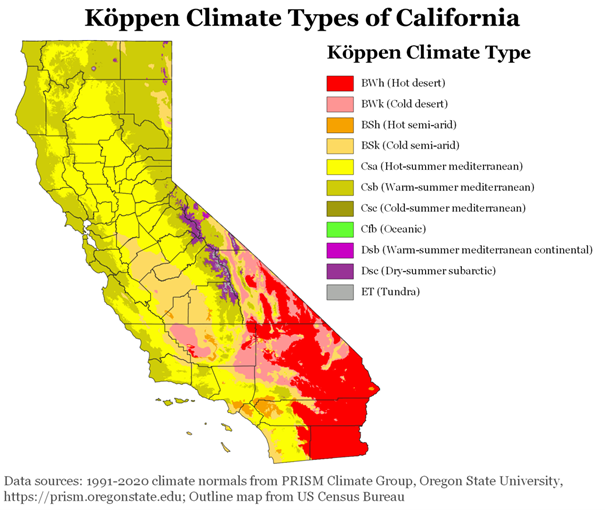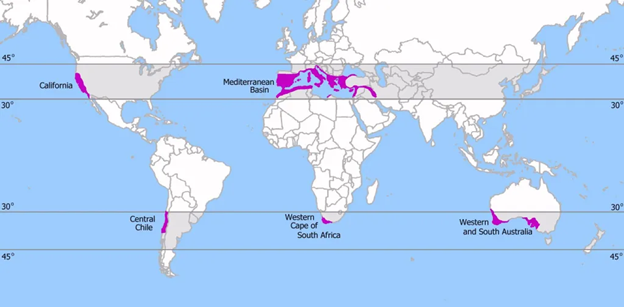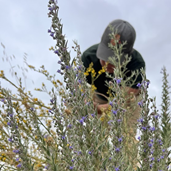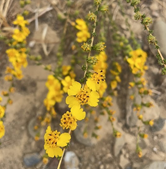Our Mediterranean Climate: Challenges and Opportunities
By Naturalist Candace Rho, September 2025
Growing up in Livermore, I was unaware of many aspects of our Mediterranean climate. As a Naturalist at the park, I am passionate about sharing information with the public, especially drawing on what I learned while earning a B.A. in Environmental Studies. I am an environmental scientist and a social scientist by education. As a naturalist by profession, I love connecting people to natural resources and the community through education.

We all share a lived experience in this Mediterranean climate, as well as the unpredictable climate conditions of the future. By nurturing and fostering community, we can become more resilient in a changing environment. Learn more from this ranger article, and if you would like to meet in person, find me at Sycamore Grove Park!
California Climate Type: Marine West Coast, Mediterranean, Alpine, and Desert
Climate, the long-term weather conditions in a given area, has a profound impact on life in any location. One of the reasons California is a biodiversity hotspot is that it has a diversity of climates and microclimates. The Bay Area experiences a marine west coast climate type in northern California, a Mediterranean climate type throughout most of California, small amounts of alpine climate in the Sierra Nevada Mountain Range, and desert climate types in southern California.
West Coast, Cold Ocean Currents: Special Conditions that Create Livermore’s Mediterranean Climate
Our local climate type for Livermore is the Mediterranean climate type, and you can observe the diverse habitats it supports at Sycamore Grove Park. Special conditions must occur to result in this mild climate type: the land must be located on the west coast of a continent, have access to cold ocean currents, and be situated in mid-latitude regions on the Earth. These conditions usually result in warm, dry summers and mild, cool, wet winters. This further results in drought-tolerant plants and wildlife. Reference: The Mediterranean climate. Gardening in the Mediterranean climates worldwide

Not All Mediterranean Climates are on the Mediterranean Sea
Though the Mediterranean climate gets its name from the Mediterranean Sea, this climate type can also be found in Central Chile, South Africa, Australia, and California. The two main seasons in this climate type are summer and winter. The seasonal changes occur due to variations in ocean currents/ocean water upwelling, atmospheric circulation patterns, and water/sea surface temperatures.
Similar to weather near the Mediterranean Sea, our Livermore summer conditions occur when cold ocean currents bring in dry air with little to no precipitation. During winter, the currents shift, bringing warmer, moist air that leads to precipitation. This mild climate type receives an average of 20 inches of rainfall per year (compared to a tropical climate type, which receives 70 – 100+ inches per year!). Specifically, in Livermore, the situation can be even more extreme, with an average annual rainfall of 14 to 15 inches.
Let’s get to the good stuff: food, trees, shrubs, and more
Fruit trees and vines such as grapes, figs, olives, and citrus fruits grow very well here. It is not a coincidence that Olive orchards (such as Sycamore Grove Park’s neighbor, Olivina) and vineyards succeed in the Livermore Valley! California is a powerhouse for agricultural and viticultural production, not only because of its climate, but also due to its unique soils and geologic history. Other important plants found in California include evergreens (such as Pine and Cypress trees) mixed with deciduous trees (example: Blue oak and Valley oak). Deciduous plants are plants that lose their leaves for part of the year, while evergreens keep their leaves all year long. Scrub plant communities include small shrubs, grasses, and herbs. I invite you to the native gardens at Sycamore Grove Park to explore these drought-resistant plant communities and see the neighboring vineyards and Olivina!
Fire and the Mediterranean Climate
California has experienced a Mediterranean climate for the last 3 million years (to put this into perspective, modern-day humans have only been around for ~200,000 years, while our early ancestors have been around for at least 2 million years!). That’s a long time for the wildlife to adapt to a natural result of those warm, dry summers: fire. And in more recent times, the fire at play was often human-made. Fire was undoubtedly a tool used by First Nations Peoples of California (Indigenous Americans have been here for ~20,000 years). Fire plays a key role for wildlife, people, and native plant communities. Fire helps plants germinate and reproduce, makes room for new growth, removes dead vegetation, controls pests, restores nutrients to the soil, diversifies habitats, and more. Human beings and fire have been a natural part of California for a very long time; humans use fire to burn and reduce vegetation fuel loads in preparation for the fire season characteristic of Mediterranean climate types. To ensure we thrive in the future, we must design our man-made structures with fire preparedness in mind. We must implement a permaculture perspective. Reference: Ecological history of Ca Mediterranean-type landscape_Department of Forestry and Resource Management, UC, Berkeley
Permaculture – Structural Design for Any Climate Type
Even though I emphasize how unique this climate is, I understand the heatwaves and climate variability we experience can be miserable. Energy monopolies and building/city design are partly to blame for the strenuous summers Californians experience. California developers must integrate permaculture into their construction plans. Permaculture is a design process that takes in observations of the natural environmental conditions, water flow, people's needs/community needs, climate, fire, and more, to create ecologically and socially sustainable ways of living comfortably and more efficiently, such as:
- Sunlight patterns to help increase energy efficiency for cooling and heating homes
- Roof designs to incorporate maximum efficiency for solar panels
- Permeable sidewalks and roads that mitigate flooding by including native plant communities
- More open spaces and green spaces with native habitats and plants to promote climate resiliency and human well-being.
- Community Choice Aggregations - Our homes and buildings, where we spend a significant amount of time, significantly impact our life experiences and relationships, particularly in Mediterranean climate types. Alternatives to energy monopolies can help communities thrive more sustainably.
What are Community Choice Aggregations (CCAs)?
Community Choice Aggregations (CCAs) are a potential alternative source of electricity that supports local communities. They can provide access to more clean and renewable energy, often from locally generated sources. Through CCAs, communities purchase electricity on behalf of residents and businesses, replacing investor-owned utilities such as Pacific Gas & Electric (PG&E). In the past, energy monopolies lobbied against community choice aggregations, but local citizens have the right to be aware of CCAs as an option for sustainable living and thriving in a Mediterranean climate type. Reference: Advancing Local Energy Choice: CALCCA, community choice aggregation, provides renewable energy at reduced costs
Mediterranean Climate - Final Notes
In the end, the Mediterranean climate type is special due to its rarity, the evolutionary benefits of drought-adapted wildlife, humans' thriving partnership with fire for thousands of years, the diversification of habitats and wildlife, and the availability of mild weather conditions. Instead of fighting existing climate conditions, several solutions can be implemented, and partners can be found to work with in a Mediterranean climate. If we thrive in existing conditions, we become climate-resilient and increase our odds of thriving in the face of the climate crisis. For kid-relatable information, visit this link: Climate Types for Kids | Mediterranean Climate
Vinegarweed & Tarweed: Mediterranean Climate Type Native Plants in the Park

Be sure to bring a hat, sunscreen, and water when you come to Sycamore Grove Park this fall—our Mediterranean climate’s hot and dry season extends through September! In the fall, you can find Vinegarweed and Pitgland tarweed, native plants throughout the park.

Experience the sensory benefits of these plants that thrive in this climate type! Vinegarweed and Pitgland Tarweed plants are unique native flowers in bloom this time of year. As the name suggests, Vinegarweed will have a strong, vinegar-like smell. Pay attention to the design of the plant as it is perfectly shaped to ‘tickle’ pollinators with its pollen. The other drought-tolerant plant, Pitgland tarweed, has a sticky texture, and the smell reminds me of citrus fruit. Please do not pluck these special native flora, and leave them for wildlife and for future generations of drought-resistant flowers to continue flourishing.
